Indesit WI142 User Manual

Instructions for use
|
|
|
|
|
|
|
WASHING MACHINE |
||
|
|
|
|
|
|
|
|
|
|
|
|
|
|
|
|
|
|
|
|
|
|
|
|
|
|
|
Contents |
|
|
|
|
|
|
|
|
|
GB |
||
|
|
|
|
|
|
|
|
|
|
|
|
|
|
|
|
|
Installation, 2-3 |
|
|
|
GB |
|
NL |
|
F |
|
|
||
|
|
|
|
Unpacking and levelling, 2 |
|||||
|
|
|
|
|
|
|
Electric and water connections, 2-3 |
||
|
|
|
|
|
|
|
|||
|
English,1 |
Nederlands,13 |
Français,25 |
The first wash cycle, 3 |
|||||
|
|
|
|
|
|
|
Technical details, 3 |
||
DE
Deutsch,37
WI 142
Washing machine description, 4-5
Control panel, 4 Leds, 5
Starting and Programmes, 6
Briefly: how to start a programme, 6 Programme table, 6
Personalisations, 7
Setting the temperature, 7
Functions, 7
Detergents and laundry, 8
Detergent dispenser, 8
Preparing your laundry, 8
Special items, 8
Precautions and advice, 9
General safety, 9 Disposal, 9
Saving energy and respecting the environment, 9
Care and maintenance, 10
Cutting off the water or electricity supply, 10 Cleaning your appliance, 10
Cleaning the detergent dispenser, 10 Caring for your appliance door and drum, 10 Cleaning the pump, 10
Checking the water inlet hose, 10
Troubleshooting, 11
Service, 12
Before calling for Assistance, 12
1
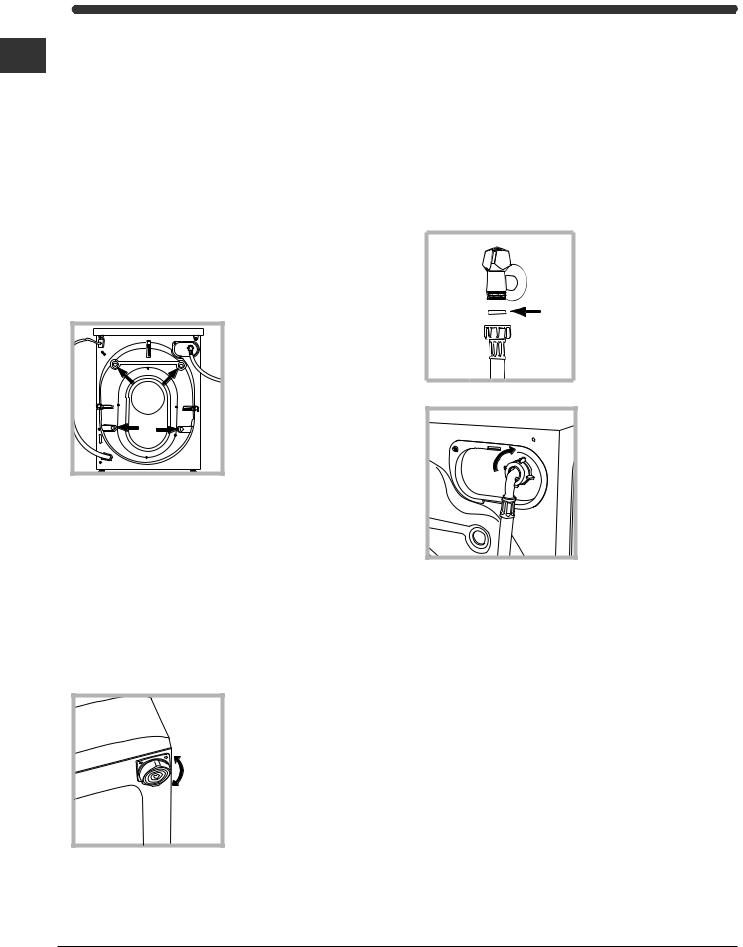
Installation
Keep this instruction manual in a safe place for GB future reference. Should the appliance be sold,
transferred or moved, make sure the instruction manual accompanies the washing machine to inform the new owner as to its operation and features.
Read these instructions carefully: they contain vital information on installation, use and safety.
Unpacking and levelling
Unpacking
1.Unpack the washing machine.
2.Check whether the washing machine has been damaged during transport. If this is the case, do not install it and contact your retailer.
3. Remove the 4 protective screws and the rubber washer with the respective spacer, situated on the rear of the appliance (see figure).
4.Seal the gaps using the plastic plugs provided.
5.Keep all the parts: you will need them again if the washing machine needs to be moved to another location.
Packaging materials are not children's toys.
Levelling
1. Install the washing machine on a flat sturdy floor, without resting it up against walls, furniture cabinets or other.
2. If the floor is not perfectly level, compensate for any unevenness
by tightening or
loosening the adjustable
front feet (see figure); the angle of inclination, measured according to the worktop, must not exceed 2°.
Levelling your appliance correctly will provide it with stability and avoid any vibrations, noise and shifting during operation. If it is placed on a fitted or loose carpet, adjust the feet in such a way as to allow enough room for ventilation beneath the washing machine.
Electric and water connections
Connecting the water inlet hose
1. Insert seal A into the end of the inlet hose and screw the latter onto a cold water tap with a 3/4 gas threaded
A |
mouth (see figure). |
|
|
|
Before making the |
|
connection, allow the |
|
water to run freely until |
|
it is perfectly clear. |
|
2. Connect the other end |
|
of the water inlet hose to |
|
the washing machine, |
|
screwing it onto the |
|
appliance's cold water |
|
inlet, situated on the top |
|
right-hand side on the |
|
rear of the appliance |
|
(see figure). |
3. Make sure there are no kinks or bends in the hose.
The water pressure at the tap must be within the values indicated in the Technical details table
(on the next page).
If the water inlet hose is not long enough, contact a specialist store or an authorised serviceman.
2
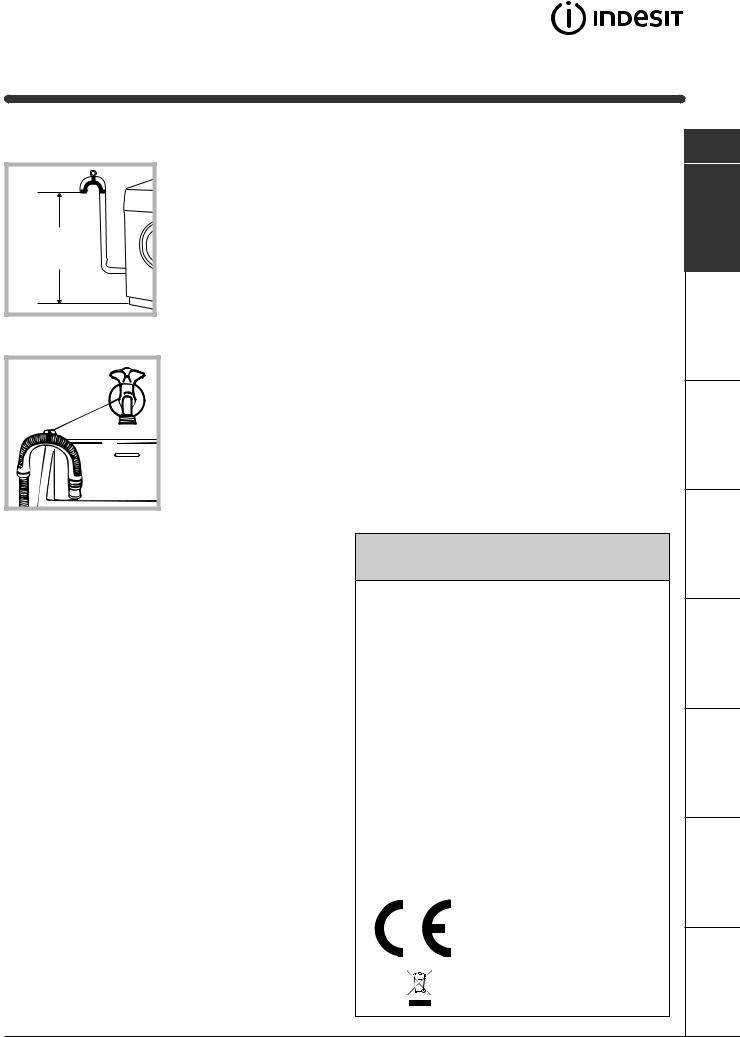
Connecting the drain hose
65 - 100 cm |
Connect the drain hose, without bending it, to a draining duct or a wall drain situated between 65 and 100 cm from the floor;
alternatively, place it over the edge of a basin, sink or tub, fastening the duct supplied to the tap (see figure). The free end of the hose should not be underwater.
We advise against the use of hose extensions; in case of absolute need, the extension must have the same diameter as the original hose and must not exceed 150 cm in length.
Electric connection
Before plugging the appliance into the mains socket, make sure that:
•the socket is earthed and in compliance with the applicable law;
•the socket is able to sustain the appliance's maximum power load indicated in the Technical details table (on the right);
•the supply voltage is included within the values i ndicated on the Technical details table
(on the right);
•the socket is compatible with the washing machine's plug. If this is not the case, replace the socket or the plug.
The washing machine should not be installed in an outdoor environment, not even when the area is sheltered, because it may be very dangerous to leave it exposed to rain and thunderstorms.
When the washing machine is installed, the mains socket must be within easy reach.
Do not use extensions or multiple sockets.
The power supply cable must never be bent or dangerously compressed.
The power supply cable must only be replaced by an authorised serviceman.
Warning! The company denies all liability if and when these norms are not respected.
The first wash cycle
Once the appliance has been installed, and before you use it for the first time, run a wash cycle with detergent and no laundry, setting the 90°C programme without a pre-wash cycle.
Technical details
Model |
WI 142 |
|
|
|
|
|
59.5 cm wide |
|
Dimensions |
85 cm high |
|
|
53.5 cm deep |
|
|
|
|
Capacity |
from 1 to 5 kg |
|
|
|
|
Electric |
voltage 220/230 Volts 50 Hz |
|
connections |
maximum absorbed power 1850 W |
|
|
|
|
Water |
maximum pressure 1 MPa (10 bar) |
|
minimum pressure 0.05 MPa (0.5 bar) |
||
connections |
||
drum capacity 46 litres |
||
|
||
|
|
|
Spin speed |
up to 1400 rpm |
|
|
|
|
Control |
|
|
programmes |
programme 3; temperature 60°C; |
|
according to |
run with a load of 5 kg. |
|
IEC456 directive |
|
|
|
|
|
|
This appliance is compliant with the |
|
|
following European Community |
|
|
Directives: |
|
|
- 73/23/CEE of 19/02/73 (Low |
|
|
Voltage) and subsequent amendments |
|
|
- 89/336/CEE of 03/05/89 |
|
|
(Electromagnetic Compatibility) and |
|
|
subsequent amendments |
|
|
- 2002/96/CE |
GB
Precautions Detergents Programmes Description Installation
Service Troubleshooting Care
3
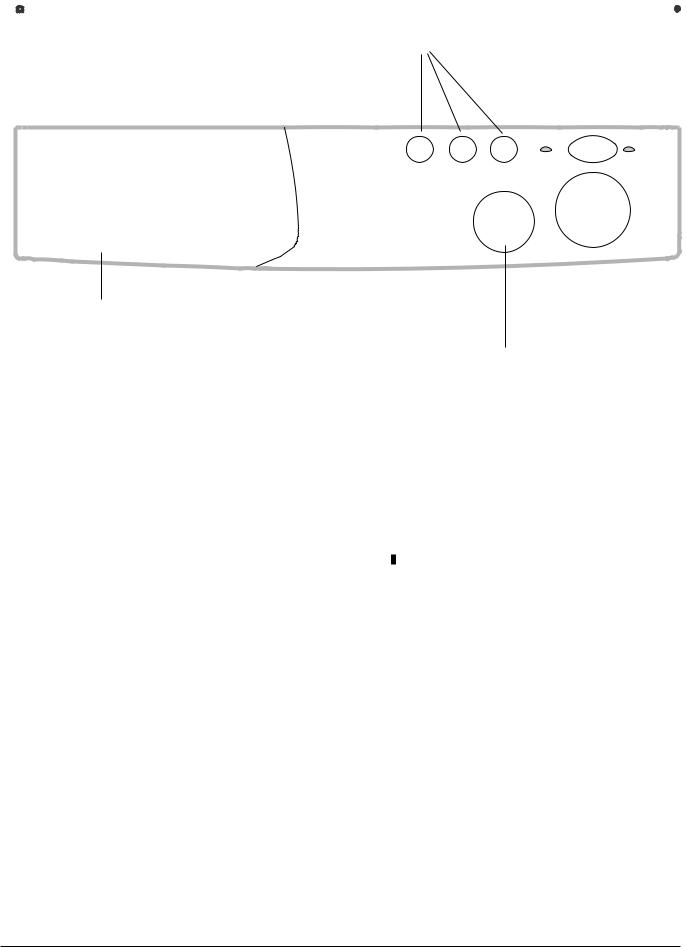
Washing machine description
|
|
|
|
|
|
|
|
|
|
|
|
Control panel |
FUNCTION |
DOOR |
|
|
|
|
|||
|
|
|
|
|
||||||
GB |
|
|
Buttons |
|
|
|
|
|||
|
|
|
LOCK |
|
ON-OFF |
|||||
|
|
|
|
|||||||
|
|
|
|
Led |
|
|
|
Button |
||
|
|
|
|
|
|
|||||
|
|
|
|
|||||||
|
|
|
|
|
|
|
|
|
ON-OFF |
|
|
|
|
|
|
|
|
|
|
||
|
|
|
|
|
|
|
|
|
Led |
|
|
|
|
|
|
|
|
|
|
|
|
|
|
|
|
|
|
|
|
|
|
|
|
|
PROGRAMME |
Detergent dispenser |
|
Knob |
|
TEMPERATURE
Knob
Detergent dispenser: to add detergent and fabric softener (see page 8).
FUNCTION buttons: to select the functions available.
TEMPERATURE knob: to set the temperature or the cold wash cycle (see page 7).
DOOR LOCK led, to find out if the appliance door can be opened (see page 5).
ON/OFF button, to turn the washing machine on and off.
Turning the machine off does not cancel the selected programme.
ON/OFF led, to find out whether the washing machine is on and if the programme set has been accepted (see page 5).
PROGRAMME knob: to select the wash programmes.
Note: After the wash cycle has been set and accepted by the washing machine, any changes to the position of the knob will be of no use (except in the Stop/Reset position).
Turn this knob clockwise only.
4

Leds
The LEDS provide important information. This is what they can tell you:
DOOR LOCK Led
The safety led indicates that the washing machine door is locked to prevent it from being opened accidentally. To avoid any damages to lock mechanism, you must wait for the led to extinguish, before attempting to open the door which takes around three minutes.
ON-OFF Led
Led flashes when the appliance is switched on and awaiting a programme to be set. A steady light means the appliance has accepted the selected programme.
GB
Precautions Detergents Programmes Description Installation
Service Troubleshooting Care
5

Starting and Programmes
Briefly: starting a programme
GB |
1. |
Set the desired programme. |
||
|
||||
|
2. |
Set the wash temperature (see page 7). |
||
|
3. |
Load your laundry into the appliance and shut |
||
|
|
the door. |
||
|
4. |
Add the detergent and any fabric softener |
||
|
|
(see page 8). |
||
|
5. |
Turn the appliance on by pressing button |
|
. The |
|
|
|||
|
|
|||
|
|
ON/OFF led begins to flash, after 5 seconds, the |
||
|
|
setting is accepted, the led stops flashing (staying |
||
|
|
on) and the wash cycle begins. |
||
6. To cancel the cycle set, select one of the symbols (Stop/Reset) and wait 5 seconds: when the cancellation has been accepted, the ON/OFF led flashes, and you can turn the appliance off and
set a new cycle.
7.When the programme is completed, the DOOR LOCK led will turn off to indicate that the
appliance door can be opened.
Turn the washing machine off by pressing button  . Take out your laundry and leave the appliance door ajar to allow the drum to dry thoroughly.
. Take out your laundry and leave the appliance door ajar to allow the drum to dry thoroughly.
Programme table
Type of fabric and |
Program- |
Tempe- |
Detergent |
Fabric |
Cycle |
Description of wash cycle |
|||
degree of soil |
mes |
rature |
|
|
softener |
length |
|||
pre- |
wash |
(minu tes) |
|
||||||
|
|
|
|
wash |
|
|
|
|
|
Cotton |
|
|
|
|
|
|
|
|
|
Extremely soiled whites |
1 |
90°C |
• |
• |
• |
135 |
Pre-wash, wash cycle, rinse cycles, |
||
(sheets, tablecloths, etc.) |
intermediate and final spin cycles |
||||||||
|
|
|
|
|
|
|
|||
Extremely soiled whites |
2 |
90°C |
|
• |
• |
125 |
Wash cycle, rinse cycles, intermediate |
||
(sheets, tablecloths, etc.) |
|
and final spin cycles |
|||||||
|
|
|
|
|
|
|
|||
Heavily soiled whites and fast |
3 |
60°C |
|
• |
• |
110 |
Wash cycle, rinse cycles, intermediate |
||
colours |
|
and final spin cycles |
|||||||
|
|
|
|
|
|
|
|||
Slightly soiled whites and delicate |
4 |
40°C |
|
• |
• |
70 |
Wash cycle, rinse cycles, intermediate |
||
colours (shirts, jumpers, etc.) |
|
and final spin cycles |
|||||||
|
|
|
|
|
|
|
|||
Rinse cycles |
|
|
|
|
|
• |
|
Rinse cycles, intermediate and final spin |
|
|
|
|
|
|
|
cycles |
|||
|
|
|
|
|
|
|
|
||
Spin cycle |
|
|
|
|
|
|
|
Draining and final spin cycle |
|
|
|
|
|
|
|
|
|
|
|
Stop/Reset |
|
|
|
|
|
|
|
Interrupts/Cancels the selected programme |
|
|
|
|
|
|
|
|
|||
|
|
|
|
|
|
|
|
|
|
Synthetics |
|
|
|
|
|
|
|
|
|
Heavily soiled fast colour synthetics |
5 |
60°C |
|
• |
• |
75 |
Wash cycle, rinse cycles, anti-crease or |
||
(baby linen, etc.) |
|
delicate spin cycle |
|||||||
|
|
|
|
|
|
|
|||
Delicate colour synthetics (all types |
6 |
40°C |
|
• |
• |
60 |
Wash cycle, rinse cycles, anti-crease or |
||
of slightly soiled garments) |
|
delicate spin cycle |
|||||||
|
|
|
|
|
|
|
|||
Rinse cycle |
|
|
|
|
|
• |
|
Rinse cycles, anti-crease or delicate spin |
|
|
|
|
|
|
|
cycle |
|||
|
|
|
|
|
|
|
|
||
Fabric softener |
|
|
|
|
|
• |
|
Rinse cycles with automatic introduction of |
|
|
|
|
|
|
|
softener, anti-crease or delicate spin cycle |
|||
|
|
|
|
|
|
|
|
||
Spin cycle |
|
|
|
|
|
|
|
Draining and delicate spin cycle |
|
|
|
|
|
|
|
|
|
|
|
Stop/Reset |
|
|
|
|
|
|
|
Interrupts/Cancels the selected programme |
|
|
|
|
|
|
|
|
|||
|
|
|
|
|
|
|
|
|
|
Delicates |
|
|
|
|
|
|
|
|
|
Hand wash (Wool) |
7 |
40°C |
|
• |
• |
50 |
Wash cycle, rinse cycles, anti-crease and |
||
|
delicate spin cycle |
||||||||
|
|
|
|
|
|
|
|
||
Particularly delicate garments and |
8 |
30°C |
|
• |
• |
45 |
Wash cycle, rinse cycles, anti-crease or |
||
fabrics (curtains, silk, viscose, etc.) |
|
draining |
|||||||
|
|
|
|
|
|
|
|||
Rinse cycles |
|
|
|
|
|
• |
|
Rinse cycles, anti-crease or draining |
|
|
|
|
|
|
|
|
|
|
|
Spin cycle |
|
|
|
|
|
|
|
Draining and delicate spin cycle |
|
|
|
|
|
|
|
|
|
|
|
Drain |
|
|
|
|
|
|
|
Drain |
|
|
|
|
|
|
|
|
|
|
|
Stop/Reset |
|
|
|
|
|
|
|
Interrupts/Cancels the selected programme |
|
|
|
|
|
|
|
|
|||
|
|
|
|
|
|
|
|
|
|
Notes
for the description of the Anti-crease function, please see page 7. The information contained in the table is purely indicative.
6
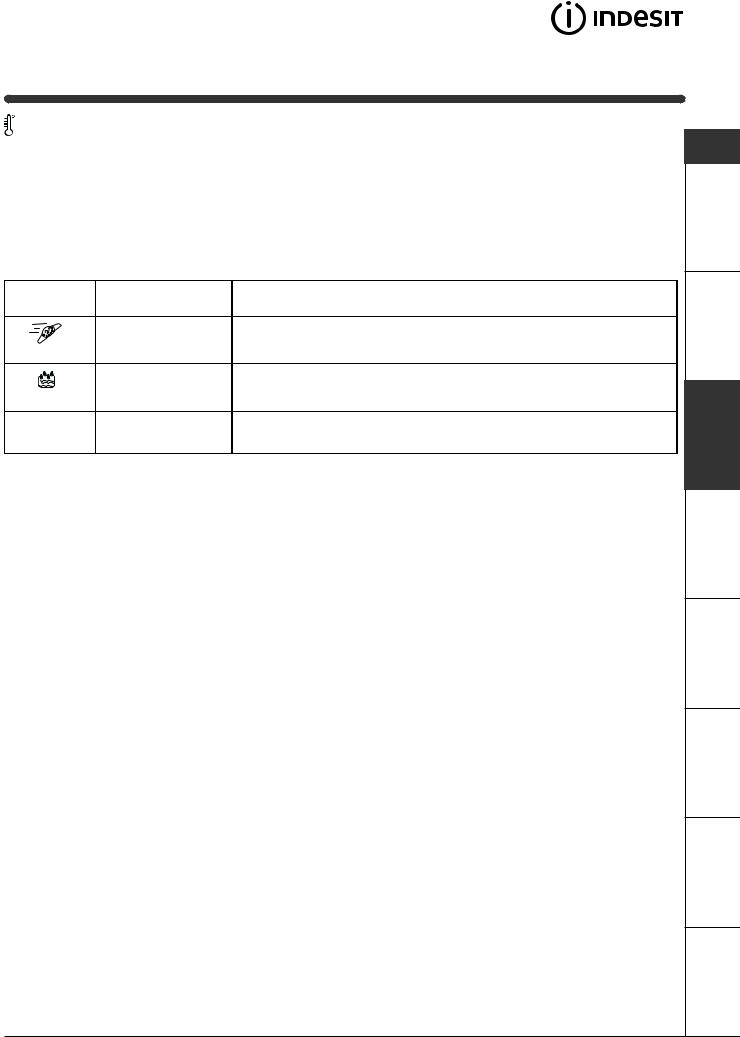
Personalisations
Setting the temperature
Turn the TEMPERATURE knob to set the wash temperature (see Programme table on page 6). The temperature can be lowered, or even set to a cold wash ( ).
).
Functions
To enable the functions, press the button corresponding to the desired function, according to the table below.
Function |
Effect |
Comments |
|
|
Cuts the duration of |
|
|
|
the wash cycle by |
It cannot be used together with the programmes for wool and silk. |
|
Rapid |
30%. |
|
|
|
Increases the |
Recommended when the appliance has a full load or with large quantities |
|
|
efficiency of the |
||
|
of detergent. |
||
Extra Rinse |
rinse. |
||
|
|||
|
Reduces the spin |
|
|
1400-600 |
speed. |
|
|
|
|
Anti-crease
This function (represented by the symbol  ) interrupts the wash programme, keeping the washing soaking in water before draining. It is only enabled in programmes for synthetic fabrics, silk and curtains. It is very useful, because it prevents delicate and synthetic fabrics from creasing (for example, when you cannot take the washing out at the end of the wash cycle but only a few hours later). The programme can be completed by turning knob PROGRAMME one notch. In the case of synthetic fabrics, should you prefer draining rather than a spin cycle, turn knob PROGRAMME until you have selected the symbol
) interrupts the wash programme, keeping the washing soaking in water before draining. It is only enabled in programmes for synthetic fabrics, silk and curtains. It is very useful, because it prevents delicate and synthetic fabrics from creasing (for example, when you cannot take the washing out at the end of the wash cycle but only a few hours later). The programme can be completed by turning knob PROGRAMME one notch. In the case of synthetic fabrics, should you prefer draining rather than a spin cycle, turn knob PROGRAMME until you have selected the symbol  .
.
GB
Precautions Detergents Programmes Description Installation
Service Troubleshooting Care
7
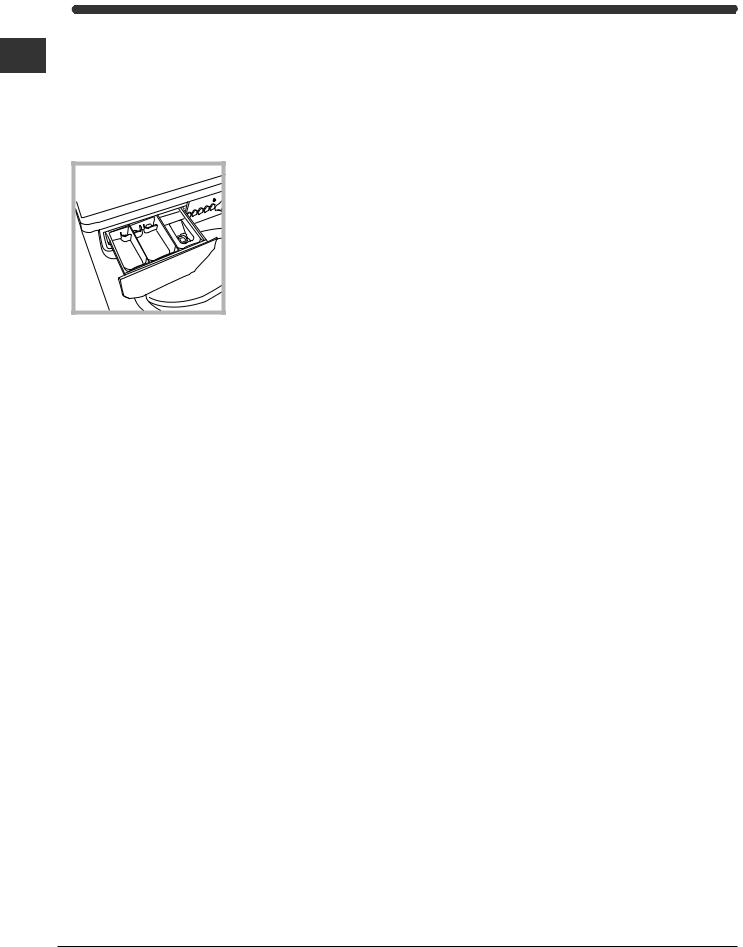
Detergents and laundry
Detergent dispenser
GB
Good washing results also depend on the correct dose of detergent: adding too much detergent won't necessarily make for a more efficient wash, and may in fact cause build up on the interior of your appliance and even pollute the environment.
|
3 |
1 |
2 |
Open up the detergent dispenser and pour in the detergent and fabric softener, as follows.
compartment 1: Detergent for pre-wash (powder)
compartment 2: Detergent for the wash cycle (powder or liquid)
Liquid detergent should only be poured in immediately prior to the wash cycle start. compartment 3: Additives (fabric softeners, etc.)
The fabric softener should not overflow from the grid.
Do not use hand wash detergent because it may form too much foam.
Special items
Curtains: fold curtains and place them in a pillow case or mesh bag. Wash them separately without exceeding half the appliance load. Use programme 8 which excludes the spin cycle automatically.
Quilted coats and windbreakers: if they are padded with goose or duck down, they can be machine-washed. Turn the garments inside out and load a maximum of 2-3 kg, repeating the rinse cycle once or twice and using the delicate spin cycle. Trainers: remove any mud. They can be washed together with jeans and other tough garments, but not with whites.
Wool: for best results, use a specific detergent, taking care not to exceed a load of 1 kg.
Preparing your laundry
•Divide your laundry according to:
-the type of fabric/the symbol on the label.
-the colours: separate coloured garments from whites.
•Empty all pockets and check for loose buttons.
•Do not exceed the weight limits stated below, which refer to the weight when dry:
Sturdy fabrics: max 5 kg Synthetic fabrics: max 2.5 kg Delicate fabrics: max 2 kg Wool: max 1 kg
How much does your laundry weigh?
1sheet 400-500 g
1pillow case 150-200 g
1tablecloth 400-500 g
1bathrobe 900-1,200 g
1towel 150-250 g
8
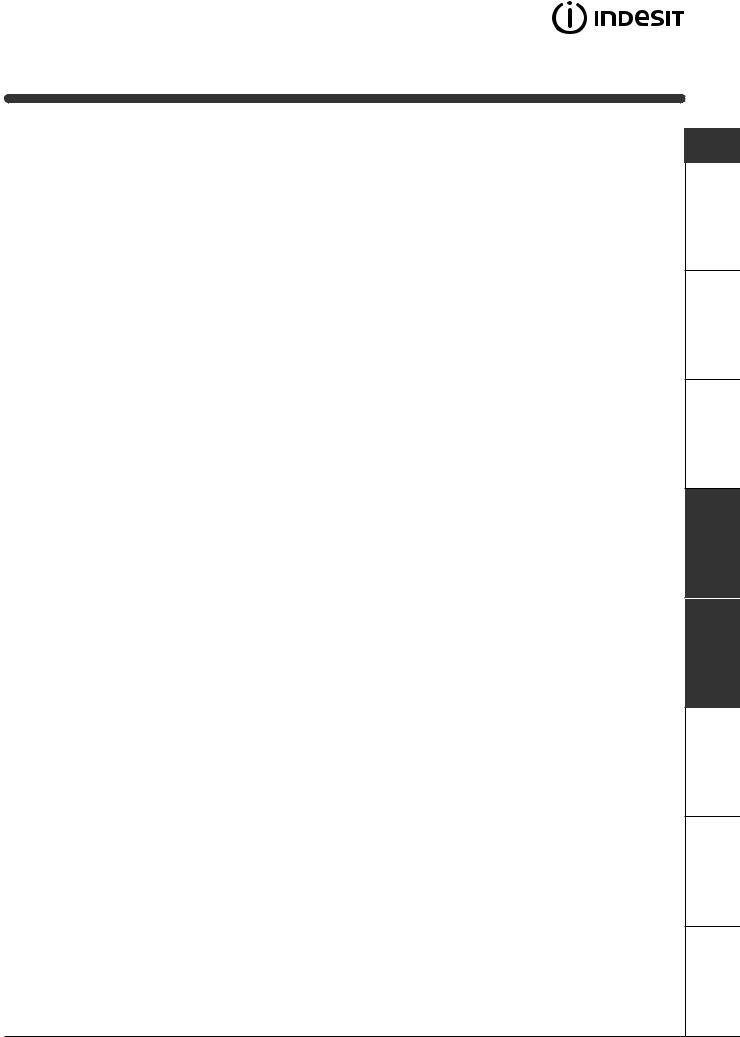
Precautions and advice
The washing machine was designed and built in compliance with the applicable international safety regulations. The following information is provided for your safety and should consequently be read carefully.
General safety
•This appliance has been designed for nonprofessional, household use and its functions must not be changed.
•This washing machine should only be used by adults and in accordance with the instructions provided in this manual.
•Never touch the washing machine when barefoot or with wet or damp hands or feet.
•Do not pull on the power supply cable to unplug the appliance from the electricity socket. Pull the plug out yourself.
•Do not open the detergent dispenser while the appliance is in operation.
•Do not touch the drain water as it could reach very high temperatures.
•Never force the washing machine door: this could damage the safety lock mechanism designed to prevent any accidental openings.
•In the event of a malfunction, do not under any circumstances touch internal parts in order to attempt repairs.
•Always keep children well away from the appliance while in operation.
•The appliance door tends to get quite hot during the wash cycle.
•Should it have to be moved, proceed with the help of two or three people and handle it with the utmost care. Never try to do this alone, because the appliance is very heavy.
•Before loading your laundry into the washing machine, make sure the drum is empty.
Disposal
•Disposing of the packaging material:
observe local regulations, so the packaging can be re-used.
•The European Directive 2002/96/EC on Waste Electrical and Electronic Equipment, requires that old household electrical appliances must not be disposed of in the normal unsorted municipal waste stream. Old appliances must be collected separately in order to optimise the recovery and recycling of the materials they contain and reduce
the impact on human health and the environment. The crossed out "wheeled bin" symbol on the product reminds you of your obligation, that when you dispose of the appliance it must be separately collected.
Consumers should contact their local authority or retailer for information concerning the correct disposal of their old appliance.
Saving energy and respecting the environment
Environmentally-friendly technology
If you only see a little water through your appliance door, this is because thanks to the latest Indesit technology, your washing machine only needs less than half the amount of water to get the best results: an objective reached to respect the environment.
Saving on detergent, water, energy and time
•To avoid wasting resources, the washing machine should be used with a full load. A full load instead of two half loads allows you to save up to 50% on energy.
•The pre-wash cycle is only necessary on extremely soiled garments. Avoiding it will save on detergent, time, water and between 5 and 15% energy.
•Treating stains with a stain remover or leaving them to soak before washing will cut down the need to wash them at high temperatures. A programme at 60°C instead of 90°C or one at 40°C instead of 60°C will save up to 50% on energy.
•Use the correct quantity of detergent depending on the water hardness, how soiled the garments are and the amount of laundry you have, to avoid wastage and to protect the environment: despite being biodegradable, detergents do contain ingredients that alter the natural balance of the environment. In addition, avoid using fabric softener as much as possible.
•If you use your washing machine from late in the afternoon until the early hours of the morning, you will help reduce the electricity board's peak load.
•If your laundry has to be dried in a tumble dryer, select a high spin speed. Having the least water possible in your laundry will save you time and energy in the drying process.
GB
Precautions Detergents Programmes Description Installation
Service Troubleshooting Care
9
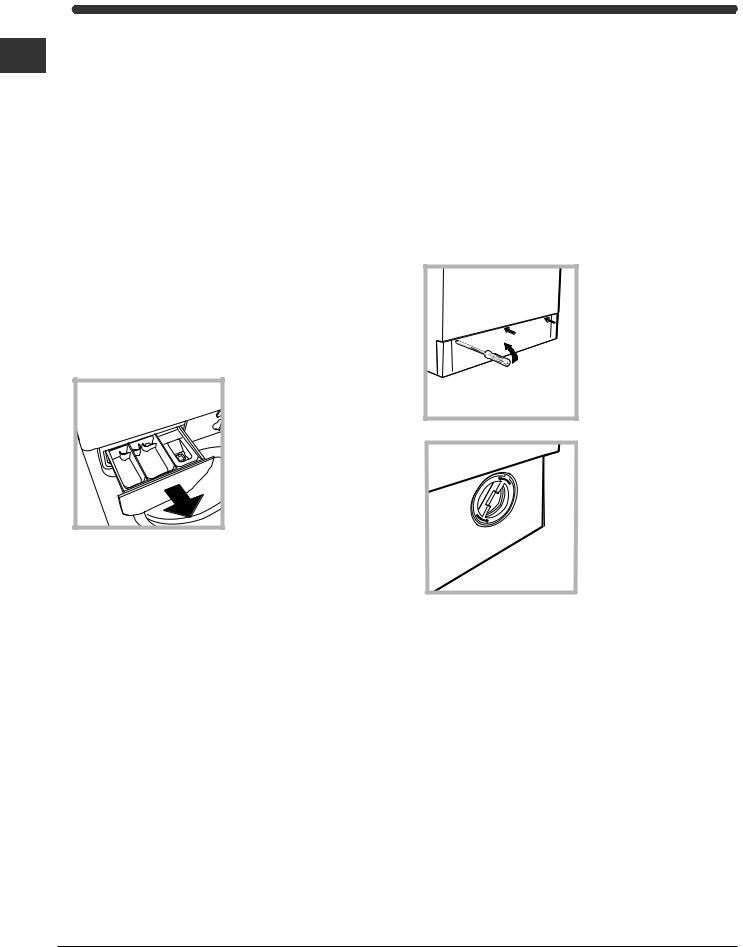
Care and maintenance
Cutting off the water or electricity GB supply
•Turn off the water tap after every wash. This will limit the wear of your appliance's water system and also prevent leaks.
•Unplug your appliance when cleaning it and during all maintenance operations.
Cleaning your appliance
The exterior and rubber parts of your appliance can be cleaned with a soft cloth soaked in lukewarm soapy water. Do not use solvents or abrasives.
Cleaning the detergent dispenser
Remove the dispenser by pulling it out (see figure).
Wash it under running water; this operation should be repeated frequently.
Caring for your appliance door and drum
•Always leave the appliance door ajar to prevent unpleasant odours from forming.
Cleaning the pump
The washing machine is fitted with a self-cleaning pump that does not require any maintenance. Sometimes, small items (such as coins or buttons) may fall into the pre-chamber that protects the pump, situated in the lower part of the same.
Make sure the wash cycle has ended and unplug the appliance.
To access the pre-chamber:
1. using a screwdriver, remove the cover panel on the lower front of the washing machine (see figure);
2. unscrew the lid rotating it anticlockwise (see figure): a little water may trickle out. This is perfectly normal;
3.clean the interior thoroughly;
4.screw the lid back on;
5.reposition the panel, making sure the hooks are securely in place before you push it onto the appliance.
Checking the water inlet hose
Check the water inlet hose at least once a year. If you see any cracks, replace it immediately: during the wash cycles, water pressure is very strong and a cracked hose could easily split open.
Never use hoses that have already been used.
10
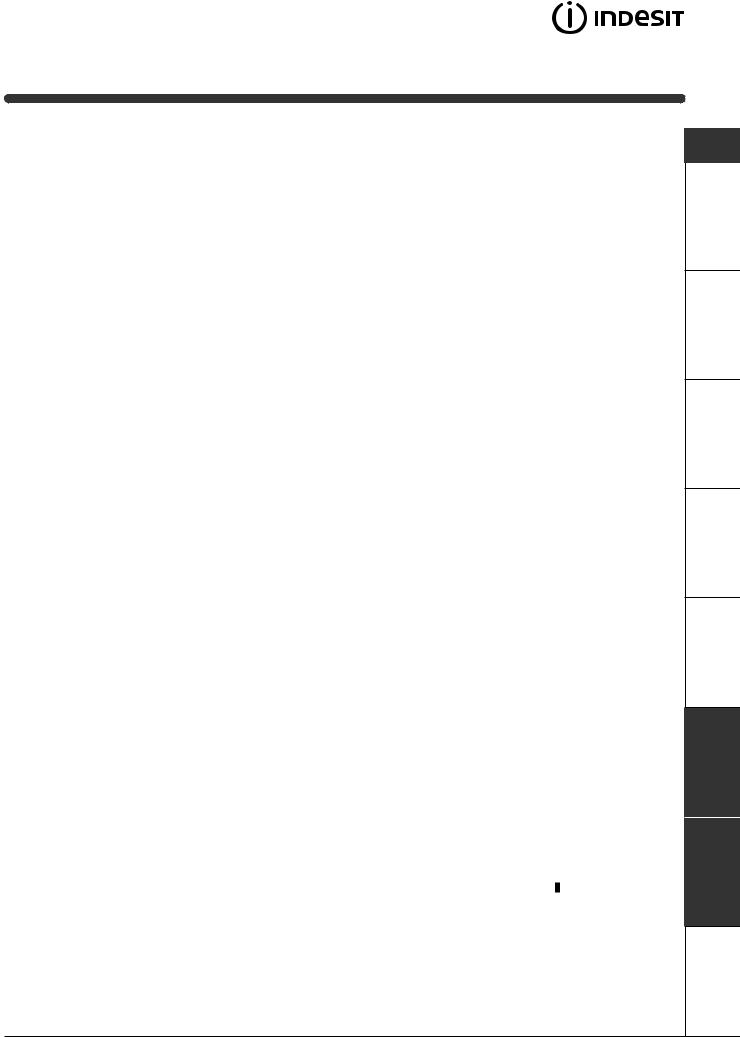
Troubleshooting
Your washing machine could fail to work. Before calling for Assistance (see page 12), make sure the problem can't easily be solved by consulting the following list.
Problem
The washing machine won't start.
The wash cycle won't start.
Possible causes/Solution:
•The appliance is not plugged into the socket, or not enough to make contact.
•There has been a power failure.
•The appliance door is not shut properly.
•The  button has not been pressed.
button has not been pressed.
•The water tap is not turned on.
The washing machine fails to load water.
The washing machine continuously loads and unloads water.
The washing machine does not drain or spin.
•The water inlet hose is not connected to the tap.
•The hose is bent.
•The water tap is not turned on.
•There is a water shortage.
•The water pressure is insufficient.
•The drain hose is not fitted between 65 and 100 cm from the floor
(see page 3).
•The free end of the hose is underwater (see page 3).
•The wall drainage system doesn't have a breather pipe.
If the problem persists even after these checks, turn off the water tap, switch the appliance off and call for Assistance. If the dwelling is on one of the upper floors of a building, there may be drain trap problems causing the washing machine to load and unload water continuously. In order to avoid such an inconvenience, special anti-drain trap valves are available in shops.
•The programme does not foresee the draining: some programmes require enabling the draining manually (see page 6).
•The Anti-crease function is enabled (where available): This function requires enabling the draining manually.
•The drain hose is bent (see page 3).
•The drain duct is clogged.
The washing machine vibrates • The drum was not unblocked correctly during installation (see page 2). too much during the spin cycle. • The washing machine is not level (see page 2).
•The washing machine is closed in between furniture cabinets and the wall (see page 2).
The washing machine leaks.
The programme selector knob keeps turning?
•The water inlet hose is not screwed on correctly (see page 2).
•The detergent dispenser is obstructed (to clean it, see page 10).
•The drain hose is not secured properly (see page 3).
•Wait a few minutes for the drain pump to empty the tub, switch the washer off, select one of the symbols stop/reset , then switch it back on. If the knob continues to turn, call for assistance because i t is showing an anomaly.
There is too much foam. • The detergent is not suitable for machine washing (it should bear the definition "for washing machines" or "hand and machine wash", or the like).
• You used too much detergent.
GB
Precautions Detergents Programmes Description Installation
Service Troubleshooting Care
11

Service
GB
Service
Before calling for Assistance:
• Check whether you can solve the problem on your own (see page 11);
•Restart the programme to check whether the problem has been solved;
•If this is not the case, contact an authorised Technical Service Centre on the telephone number provided on the guarantee certificate.
Always request the assistance of authorised servicemen.
Notify the operator of:
•the type of problem;
•the appliance model (Mod.);
•the serial number (S/N).
This information can be found on the data plate situated on the rear of the washing machine.
12

Instructies voor het gebruik
WASMACHINE
|
|
|
|
|
|
|
|
|
Inhoud |
|
|
|
|
|
NL |
||
|
|
|
|
|
|
|
|
|
Installatie, 14-15 |
|
|
|
NL |
|
|
||
|
|
Uitpakken en waterpas zetten, 14 |
|||
|
|
|
Wateren elektrische aansluiting, 14-15 |
||
|
|
|
|||
|
Nederlands |
Eerste wasprogramma, 15 |
|||
|
|
|
Technische gegevens, 15 |
||
|
|
|
Beschrijving van de wasmachine, 16-17 |
||
|
|
|
Bedieningspaneel, 16 |
||
|
|
|
Controlelampjes, 17 |
||
|
|
|
Start en programma's, 18 |
||
|
|
|
In het kort: een programma starten, 18 |
||
|
|
|
Tabel van de programma's, 18 |
||
|
|
|
Persoonlijk instellen, 19 |
||
|
|
|
Instellen van de temperatuur, 19 |
||
|
|
|
Functies, 19 |
||
|
WI 142 |
|
|
|
|
|
|
|
Wasmiddel en wasgoed, 20 |
||
|
|
|
Wasmiddellaatje, 20 |
||
|
|
|
Prepareren van het wasgoed, 20 |
||
|
|
|
Speciale stukken, 20 |
||
|
|
|
Voorzorgsmaatregelen en raadgevin- |
||
|
|
|
gen, 21 |
||
|
|
|
Algemene veiligheid, 21 |
||
|
|
|
Het afvoeren, 21 |
||
|
|
|
Bezuiniging en bescherming van het milieu, 21 |
||
|
|
|
Onderhoud, 22 |
||
|
|
|
Afsluiten van water en stroom, 22 |
||
|
|
|
Schoonmaken van de wasmachine, 22 |
||
|
|
|
Het wasmiddellaatje schoonmaken, 22 |
||
|
|
|
Reinigen van deur en trommel, 22 |
||
|
|
|
Reinigen van de pomp, 22 |
||
|
|
|
Controleer de slang van de watertoevoer, 22 |
||
|
|
|
Storingen en oplossingen, 23 |
||
|
|
|
Service, 24 |
||
|
|
|
Voordat u er de installateur bijhaalt, 24 |
||
13
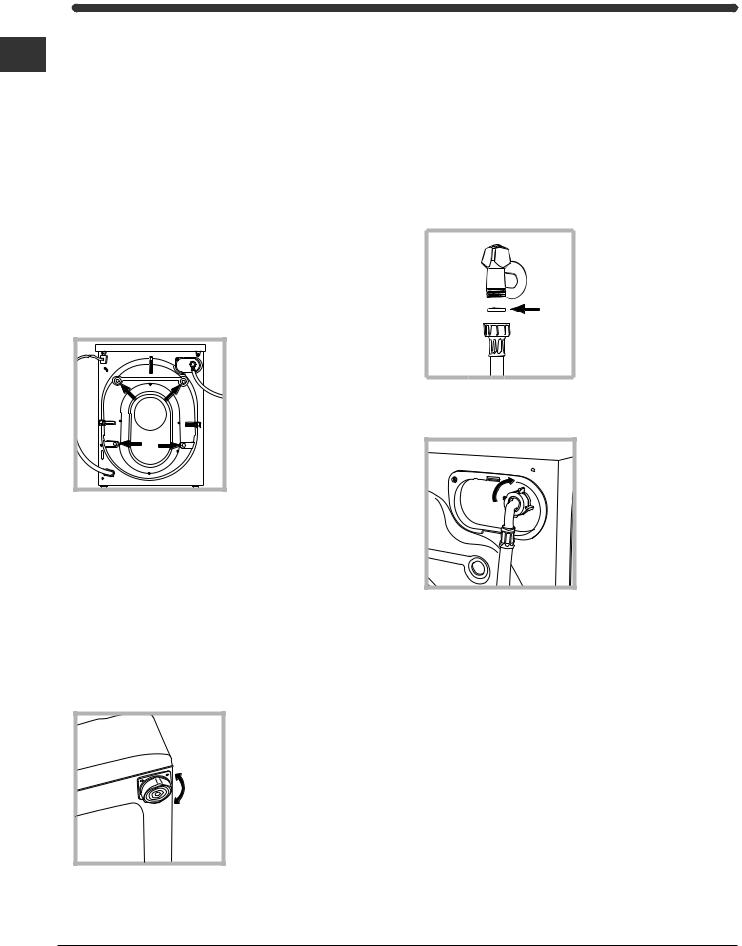
Installatie
Het is belangrijk dit boekje te bewaren zodat u het
NL |
kunt raadplegen wanneer u maar wilt. In het geval dat u |
|
|
|
de machine verkoopt, of u verhuist, moet het boekje bij |
|
de machine blijven zodat de nieuwe gebruiker de |
|
functies en betreffende raadgevingen kan leren kennen. |
|
Lees de instructies met aandacht: u vindt er belang- |
|
rijke informatie betreffende het installeren, gebruik en |
|
veiligheid. |
|
Uitpakken en waterpas zetten |
|
Uitpakken |
|
1. Pak de wasmachine uit. |
|
2. Controleer of de wasmachine geen schade heeft |
|
geleden gedurende het vervoer. Indien dit wel het |
|
geval is moet hij niet worden aangesloten en moet u |
|
contact opnemen met de handelaar. |
|
3. Verwijder de 4 |
|
transportbouten met de |
|
rubberen ring en bijbe- |
|
horende afstandstukken |
|
die zich aan de achter- |
|
kant bevinden (zie |
|
afbeelding). |
4.Sluit de gaten af met de bijgeleverde plastic doppen.
5.Bewaar alle stukken: mocht de wasmachine ooit worden vervoerd, dan moeten deze weer worden aangebracht.
Het verpakkingsmateriaal is geen speelgoed voor kinderen.
Waterpassen
1. Installeer de wasmachine op een rechte en stevige vloer en laat hem niet leunen tegen een muur, meubel of dergelijken.
2. Als de vloer niet perfect horizontaal is kunt u de onregelmatigheid opheffen door de stelvoetjes aan de voorkant inof uit te schroeven (zie afbeelding); de hoek, gemeten ten opzichte van de aanrecht, mag de 2° niet overschrijden.
Een correcte waterpas geeft de machine stabiliteit en vermijdt trillingen, lawaai en het zich verplaatsen gedurende het functioneren van de machine. In het geval van vaste vloerbedekking of een tapijt regelt u de stelvoetjes zodanig dat onder de wasmachine genoeg plaats is voor ventilatie.
Wateren elektrische aansluiting
Aansluiting van de watertoevoerslang
1. Plaats de pakking A op het uiteinde van de waterslang en schroef hem op een koudwaterkraan met een
A |
mondstuk met schroef- |
|
|
|
draad van 3/4 gas (zie |
|
afbeelding). |
|
Voordat u hem aansluit |
|
moet u het water laten |
|
lopen totdat het helder is. |
|
2. Verbind de slang aan |
|
de wasmachine door |
|
hem op de betreffende |
|
watertoevoer aan te |
|
schroeven, rechtsboven |
|
aan de achterkant (zie |
|
afbeelding). |
3. Let erop dat er geen knellingen of kronkels in de slang zijn.
De waterdruk van de kraan moet binnen de waarden van de tabel Technische Gegevens liggen (zie bladzijde hiernaast).
Als de slang niet lang genoeg is moet u zich wenden tot een gespecialiseerde handelaar of een bevoegde installateur.
14
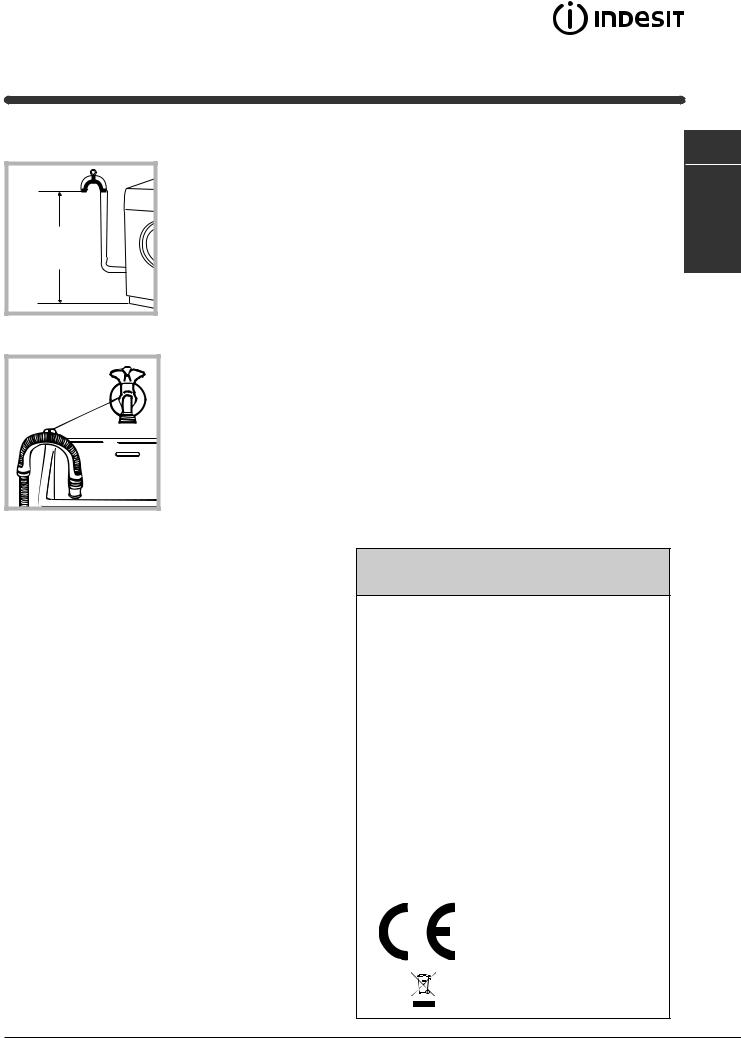
Aansluiting van de afvoerbuis
65 - 100 cm |
Verbind de buis, zonder hem te buigen, aan een afvoerleiding of aan een afvoer in de muur tussen 65 en 100 cm van de grond af;
of hang hem op de rand van een wasbak of bad, en bind de bijgeleverde leiding aan de kraan (zie afbeelding). Het uiteinde van de afvoerslang mag niet onder water hangen.
Gebruik geen verlengstuk voor de slang ; indien dit niet te vermijden is moet het verlengstuk dezelfde doorsnee hebben als de originele slang en hij mag niet langer zijn dan 150 cm.
Elektrische aansluiting
Voordat u de stekker in het stopcontact steekt moet u zich ervan verzekeren dat:
•het stopcontact geaard is en voldoet aan de geldende normen;
•het stopcontact het maximum vermogen van de machine kan verdragen, zoals aangegeven in de tabel Technische Gegevens (zie hiernaast);
•het voltage correspondeert met de waarden die zijn aangegeven in de tabel Technische Gegevens (zie hiernaast);
•het stopcontact geschikt is voor de stekker van de machine. Indien dit niet zo is moet de stekker of het stopcontact vervangen worden.
De wasmachine mag niet buiten worden geinstalleerd, ook niet op een plaats die beschut is, aangezien het gevaarlijk is hem aan regen en onweer bloot te stellen.
Als de wasmachine is geinstalleerd moet het stopcontact gemakkelijk te bereiken zijn.
Gebruik geen verlengsnoeren of dubbelstekkers.
Het snoer mag niet in bochten of geknikt liggen.
De voedingskabel mag alleen door een bevoegde installateur worden vervangen.
Belangrijk! De fabrikant is niet aansprakelijk wanneer deze normen niet gerespecteerd zijn.
Eerste wasprogramma
Voordat u de machine gaat gebruiken moet u hem een wascycle laten uitvoeren met wasmiddel maar zonder wasgoed, met het programma van 90° zonder voorwassen.
Technische gegevens
Model |
WI 142 |
|
|
|
|
|
breedte cm 59,5 |
|
Afmetingen |
hoogte cm 85 |
|
|
diepte cm 53,5 |
|
|
|
|
Vermogen |
van 1 tot 5 kg |
|
|
|
|
Elektrische |
spanning 220/230 Volt 50 Hz |
|
aansluitingen |
max. aansluitwaarde 1850 W |
|
|
|
|
Aansluiting |
max. druk 1 MPa (10 bar) |
|
min. druk 0,05 MPa (0,5 bar) |
||
waterleiding |
||
Inhoud trommel 46 liters |
||
|
||
|
|
|
Snelheid |
tot 1400 toeren per minuut |
|
centrifuge |
||
|
||
|
|
|
Controle-program- |
programma 3; temperatuur 60°C; |
|
ma's volgens de |
||
uitgevoerd met 5 kg lading. |
||
norm IEC456 |
||
|
||
|
|
|
|
Deze apparatuur voldoet aan de |
|
|
volgende EEC voorschriften: |
|
|
-73/23/EEC van 19/02/73 |
|
|
(Laagspanning) en successievelijke |
|
|
modificaties |
|
|
-89/336/EEC van 03/05/89 |
|
|
(Elektromagnetische compatiabiliteit) |
|
|
en successievelijke modificaties |
|
|
- 2002/96/CE |
NL
Installatie |
|
|
|
Beschrijving |
|
|
|
Programma's |
|
|
|
Wasmiddel |
|
|
|
maatregelen |
-Voorzorgs |
|
|
Onderhoud |
|
|
|
Storingen |
|
|
|
Service |
|
|
|
15
